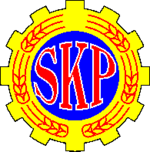This article is about the Swedish Communist Party, APK, the "Flamman group" of 1977. For other parties named "Communist Party of Sweden", see Communist Party of Sweden (disambiguation).
The Communist Party of Sweden (Sveriges Kommunistiska Parti) is the continuation of Workers' Party – The Communists (Arbetarpartiet Kommunisterna, abbreviated APK).
History
Flamman group, an orthodox pro-Soviet section with Vänsterpartiet Kommunisterna (Left Party – The Communists) that emerged as an internal fraction when C.-H. Hermansson took over as party leader and distanced the party from Moscow. The group was centered around the party newspaper Norrskensflamman (The Flame of the Aurora Borealis, usually just called Flamman), the regional party publication in Norrbotten. The fraction worked as a parallel party centre, and relations between them and the party leadership soured.
At the party congress in 1975, when Hermansson stepped down as party leader, the Flamman group launched Rolf Hagel as their candidate for party leadership. Hagel was defeated by Lars Werner with 162 votes against 74. In the same year the Flamman-sympathizers were expelled from Kommunistisk Ungdom (Communist Youth), the youth league of the party.
Part of a series on
Swedish Communism |
| Parties |
|
SKP/VPK
KFML/SKP
KPML(r)/Kommunistiska Partiet
MLK
APK/SKP
|
| Personalities |
|
Zeth Höglund
Kata Dalström
Karl Kilbom
Hugo Sillén
Sven Linderot
Set Persson
Hilding Hagberg
C.H. Hermansson
Frank Baude
Lars Werner
|
| Press |
|
Flamman
Folkets Dagblad Politiken
Arbetar-Tidningen
Proletären
|
| Related articles |
|
Communism
Politics of Sweden
|
| Communism Portal
This box: view · 1977 the group broke away, and formed Arbetarpartiet Kommunisterna (Workers Party - the Communists, abbreviated APK). A founding congress took place in the Swedish Riksdag. A large number of foreign delegated participated in the congress, indicating that APK had a strong moral support from CPSU and the orthodox sector of the World Communist Movement. Two MPs (and party central committee members), Rolf Hagel and Alf Löwenborg, were leading the split. Rolf Hagel was elected party president. Norrskensflamman became the central party organ.
In many places entire VPK party units joined APK, including in Malmö, Göteborg and Mälardalen. The foremost stronghold of the new party was Norrbotten. In total, up to 25% of the entire VPK party membership (other sources claim between 10 to 15%) joined APK. To a large extent it was the trade union cadres of VPK who joined APK. Shortly thereafter, a large section of the KU district in Gävleborg joined APK.
Sveriges Kommunistiska Ungdomsförbund (Young Communist League of Sweden) was created as the youth league of the party. A student wing, Marxistiska Studenter (Marxist Students), was founded although it never attained any importance.
The party maintained a Finnish language-publication, Siirtotyöläinen, from 1978 to 1986.[1]
APK failed to make any electoral breakthrough, and gradually the party declined. The fall of the Soviet Union came to have a very negative impact on the party. Many members left it, either to politics completely or to rejoin Vänsterpartiet. SKU broke away in 1990, and had a short-lived period as an independent communist youth organization.
In 1995 APK was declared financially bankrupt by state authorities, the first political party in Sweden to suffer that fate.
Directly after the bankruptcy of APK, the core around Hagel regrouped and reconstituted their party as Sveriges Kommunistiska Parti (Communist Party of Sweden). In 2000 SKU was reorganized as the party youth league. The party participates in elections under the nomenclature of Kommunisterna (The Communists).
Election results
In the 2006 election, the party received 438 votes.[1] 4 years later they got 375 votes. [2]
See also
External links
References
Categories: - Political parties in Sweden
- Political parties established in 1977
- Communist parties in Sweden
Wikimedia Foundation.
2010.
Look at other dictionaries:
Communist Party of Sweden — The name Communist Party of Sweden (Sveriges Kommunistiska Parti, abbreviated SKP) has been used by several political parties in Sweden: Left Party (Sweden), known as the Communist Party of Sweden between 1921 and 1967 Communist Party of Sweden… … Wikipedia Communist party (disambiguation) — Contents 1 All Union 2 Bolsheviks 3 Central, Centre 3.1 Chin … Wikipedia Communist Party (Sweden) — Not to be confused with Communist Party of Sweden. Communist Party Kommunistiska Partiet Leader Anders Carlsson … Wikipedia Communist Party of Austria — Kommunistische Partei Österreichs Leader Joint leadership of Melina Klaus and Mirko Messner Founded November 3, 1918 … Wikipedia Communist Party of the Russian Federation — Коммунистическая партия Российской Федерации Leader Gennady Zyuganov Founded 14 Feb … Wikipedia Communist Party of Indonesia — Partai Komunis Indonesia Founder Henk Sneevliet Founded May 1914 Dissolved … Wikipedia Communist Party of Pakistan — کمیونسٹ پارٹی آف پاکستان Secretary General Tanvir Ahmad Khan … Wikipedia Communist Party USA — Coordinates: 40°44′40.8″N 73°59′48.5″W / 40.744667°N 73.996806°W / 40.744667; 73.996806 … Wikipedia Communist Party of Lesotho — Lesotho This article is part of the series: Politics and government of Lesotho King Letsie III … Wikipedia Portuguese Communist Party — Partido Comunista Português Leader Jerónimo de Sousa … Wikipedia
|

